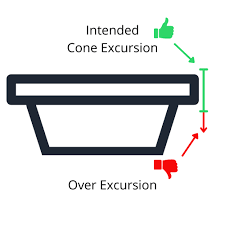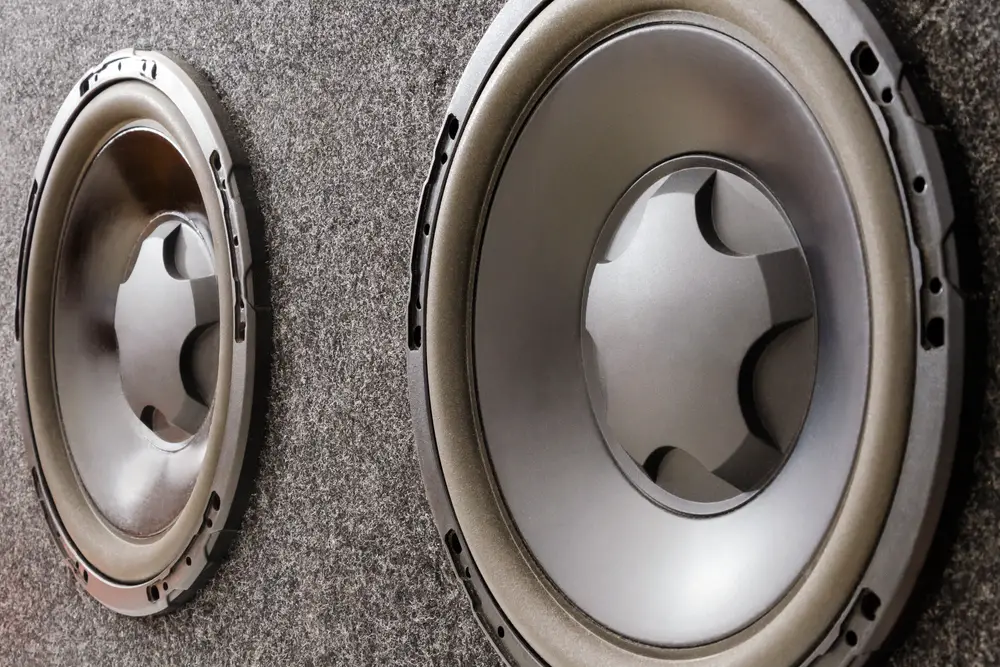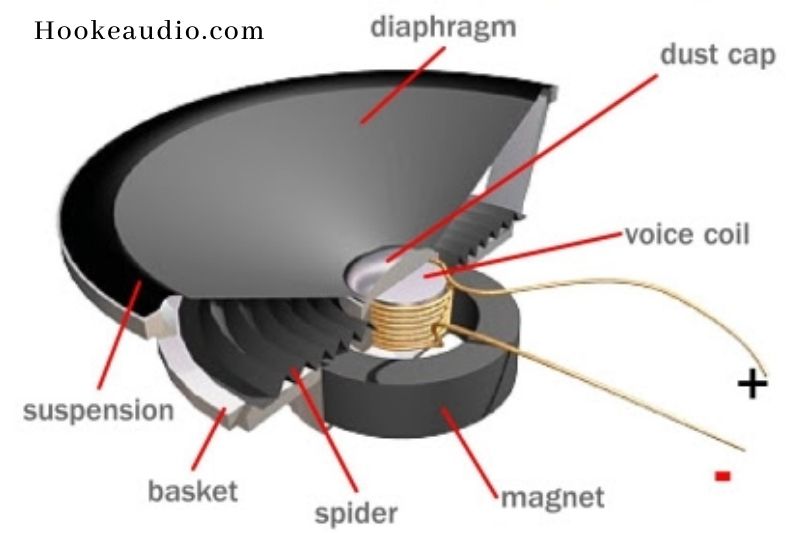Subwoofers suddenly bottoming out is one of the worst problems to have. But it’s better than having your subwoofer blow fuses all the time.
But what could be the reasons behind your subwoofer bottom out?
The subwoofer generally bottoms out when it is pushed beyond its limit while reproducing low-frequency bass. However, damaged voice coils, poor or mismatched components, and tiny subwoofers might also be to blame. Even being located on an uneven surface can cause a subwoofer to bottom out.
So let’s learn more about these problems and how to prevent them in the future.
What Does Subwoofer Bottom Out Mean?

Subwoofer bottom out means that the speaker cone of the subwoofer has been pushed way out of its excursion limit. The distance a speaker cone travels while in motion is known as its excursion.
The speaker cone of a subwoofer needs to move more air than regular speakers. This is necessary to produce low frequencies and sub-bass. This air movement is made possible by the speaker cone’s excursion.
But, there is a limit to how much speaker cone excursion is required. When this limit is crossed the subwoofer will bottom out. The term “over-excursion” is also used to describe this. Here is an example of speaker cones over excursion:
The mechanical limitations of the subwoofer driver are physically being pushed in this picture. And this is when the bottom gets detached from the subwoofer.
What Does Subwoofer Bottoming out Sound Like?

The subwoofer bottoming out will produce a jumbled or distorted sound. It is described as “thumping” or “booming.” A rattling or buzzing sound may also be produced by it.
The components of the speaker cone are made of different materials, therefore the sounds can also vary. The sounds will also vary slightly depending on whether the bottom is hard or soft.
Usually, the voice coil at the driver’s tip is the one that directly strikes the back or bottom of the subwoofer box. If you notice these sounds or suspect it, you should turn off the system and check the subwoofer.
Why is Your Subwoofer Bottoming Out?
Subwoofer bottoming out is an annoying problem just like when your subwoofer blows the fuse repeatedly. So, let’s dig deeper into the reasons behind your subwoofer bottoming out and solve the issue.
Overdriving Subwoofer:
Low frequencies take a lot of power to reproduce. But this excessive power drives the subwoofer past its mechanical power handling and physical limits.
However, it might be difficult to identify what represents excessive power. Because even particular songs or movie soundtracks can put more strain on your subwoofers than usual. This driving power is directly related to volume.
The amplifier reaches its max wattage as a result of excessive volume demands for more power. Moreover, subwoofers are frequently paired with external amplifiers. This extra volume runs with the possibility of damaging the subwoofer more than just bottoming out.
Faulty or Mismatched Components:
Damaged or mismatched components can cause the subwoofer to bottom out. In accordance with their size and material, some speaker cones need more excursion.
It’s necessary for this excursion that the subwoofer box or enclosure must be large. If it’s not, it will cause the subwoofer to bottom out. With a well-known brand, a mismatched enclosure is unlikely to happen.
But many people install their subwoofers in pre-made or personalized enclosures. The subwoofer usually bottoms out when DIY or custom-ported enclosures aren’t fit properly for the excursion region of the subwoofer.
Damaged Voice Coil:

A broken voice coil can cause the subwoofer to bottom out. A subwoofer’s voice coil turns electrical energy into mechanical energy. The subwoofer’s diaphragm is moved as a result and produces sound.
When the coil is unable to effectively move the diaphragm, it can lead it to reach the bottom of its range.
Subwoofer Too Small:
Smaller subwoofers are more likely to bottom out. Because it may lack the necessary processing capacity to handle the requirements of deep and strong bass music.
As a result, it will undoubtedly be pushed to its breaking point. Additionally, internal components in smaller subwoofers are relatively weak. This also makes them more sensitive to bottoming out.
Uneven Surface:
A subwoofer might bottom out on an uneven surface. The diaphragm cannot move freely and is more likely to strike the enclosure’s bottom when a subwoofer is set down on an uneven surface.
Both the subwoofer and the sound quality may be affected as a result. A subwoofer may also shake excessively on an uneven surface, which may result in the diaphragm hitting the internal parts.
Poor Amp Damping:
The subwoofer may not be properly controlled by an improperly damped amplifier. It can cause the subwoofer to reach the lowest point in its excursion range and bottom out.
Damping is the amplifier’s capacity to regulate the diaphragm’s motion in the subwoofer. If the damping is inadequate, the subwoofer may overshoot and undershoot the intended movement and lose control. This can harm the subwoofer and result in sound distortion or clipping.
How to Fix Subwoofer Bottoming Out Issue
Depending on the damage and the particular subwoofer type, a bottomed-out subwoofer may or may not be repairable. But even if it can be repaired, it requires professional help.
In some cases, the subwoofer’s diaphragm might have been broken, these can be replaced easily. It is normally preferable to replace the device if the damage is more severe, such as a damaged voice coil. In most cases, you will be able to get it done within $25-$100.
In any case, it’s crucial to get it fixed by a professional. After installing a new or repaired subwoofer in your home theater system, you must take precautions to ensure that it doesn’t happen again in the future.
How to Keep the Subwoofer from Bottoming Out?
Subwoofers should last between 6 and 13 years. However, it is undoubtedly a buzzkill when they abruptly start to bottom out. This typically occurs when subwoofer maintenance is neglected.
Here are some tips to help your subwoofer continue to produce powerful bass for a long time.
Lower Your Gain:
A smart place to start is always by reducing the power or gain on your subwoofer. Inspect the mechanical power handling of your subwoofer to verify it is properly matched with the amplifier.
You can reduce the power directly on the powered subwoofer panel or external amplifier, which will also reduce the gain.
Use Subsonic Filter:
Most subs can bottom out because low frequencies have more excursion than higher frequencies. A subsonic filter can be used to exclude the subwoofer from receiving extremely low frequencies between 25 Hz and below. It will filter out lower frequencies and subs won’t bottom out.
The frequencies that are removed are not essential to sound quality. Additionally, it can take out extra rumbling that might result in unpleasant vibrations. This feature is present in the majority of amplifiers and is activated by flipping a switch.
Right Enclosure Size:
If you are building a DIY subwoofer like a push-pull subwoofer you need to confirm you have the accurately sized enclosure. Naturally, a 10′′ subwoofer, and an 18′′ subwoofer will require a different enclosure.
When coupling an enclosure with a subwoofer, the port tuning must be accurate. So, always check to make sure your subwoofer can fit in the enclosure.
Crossover & Equalization:
In order to prevent the subwoofer from bottoming out, a crossover needs to be properly configured. So that it only receives the frequencies it is made to handle. You can adjust the bass response, frequency, gain, etc. to fix this.
You also need to set the equalization properly to match the room response and the main speakers. Some subwoofers come with default equalization settings.
Placement & Room Acoustics:
For the subwoofer to function properly and prevent bottoming out, precise calibration and setup are crucial. A level surface and a location that allows for the best sound quality should be chosen for the subwoofer’s placement.
It should also have sufficient ventilation. Consult with a professional or the manufacturer’s manual for instructions on subwoofer setup.
Upgrade Your Subwoofer:
All subwoofers have the same functionality but some are just superior to others. Subwoofers that cost more than others don’t only handle more power, lower frequencies are also better supported by them.
Most consumer subwoofers won’t have bottoming-out problems with proper use. However, they can be pushed too far. So, make a list of what kind of performance you want and purchase accordingly. Nobody will benefit from a subwoofer that is broken.
Frequently Asked Questions (FAQs):
Can I lay down a Subwoofer for the Home Theater Setup?
Yes, you can turn a subwoofer on its side in some cases for the home theater setup. But the subwoofer needs to be front firing otherwise, it won’t be possible. And the speaker must face the audience or the seating area in order for this to be possible.
What Is The Best Way To Break In A Subwoofer?
The best way to break in a sub is to listen to or play various music will help to break in a subwoofer. Music played at a medium volume for two weeks is mostly recommended for this. This will give the suspension and rigid cone material enough time to settle. After that, it will be safe to crank the volume and start blasting out the bass-heavy music.
Are Sealed Subs less likely to bottom out than Ported Box Subs?
No, a sealed subwoofer still has a chance of bottoming out. A subwoofer in a ported box will often generate the lowest frequencies more effectively with proper port tuning. This is why they are recommended for home theater. But many people choose sealed subwoofers because they deliver tighter bass.
End Words
This concludes our discussion on why your subwoofer bottom out. Pushing it past its limit is the main reason behind it along with others.
Hopefully, you will get your subwoofer fixed soon and follow our maintenance tips. They will keep your subwoofer running swiftly for years without any issues.
Until next time!
Read also: RCA Home Theater Projector

